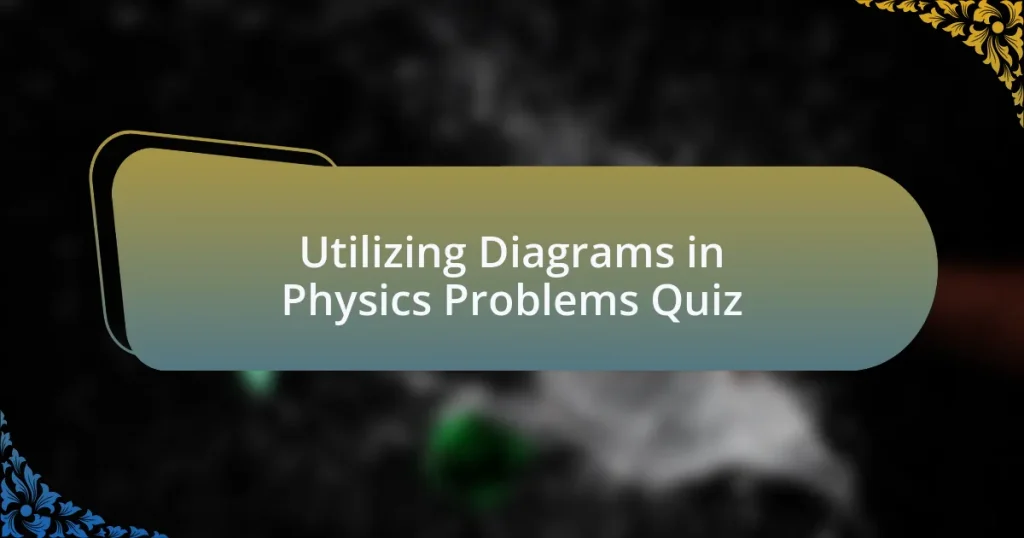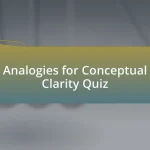Start of Utilizing Diagrams in Physics Problems Quiz
1. What is the purpose of using diagrams in physics problem-solving?
- To confuse the students with extra details.
- To visualize forces and interactions in a problem.
- To make the problems look complex.
- To decorate the physics problems.
2. How can diagrams help visualize forces acting on an object?
- Diagrams only represent the object without forces.
- Diagrams obscure the relationships between forces.
- Diagrams make calculations irrelevant for understanding forces.
- Diagrams clearly illustrate the direction and magnitude of forces.
3. What is the role of vectors in physics diagrams?
- They only show points of contact between objects.
- They identify the speed of objects without considering direction.
- They represent both direction and magnitude of forces or quantities.
- They illustrate the temperature variations in a system.
4. Why is it important to label forces in a free body diagram?
- It ensures there are no duplicate forces shown.
- It simplifies the number of forces in the diagram.
- It helps in identifying the direction and magnitude of each force.
- It makes the diagram visually appealing.
5. What does a force diagram typically illustrate in a physics problem?
- The speed of the object.
- The forces acting on an object.
- The distance traveled by the object.
- The direction of an object`s motion.
6. How does understanding diagrams assist in calculating net forces?
- It complicates the process of understanding forces.
- It helps identify the direction and magnitude of forces.
- It serves no purpose in calculating forces.
- It only applies to electrical circuits, not mechanical systems.
7. Why might a student choose to draw an inclined plane diagram?
- To measure the angle of elevation.
- To calculate the weight of the object.
- To analyze the forces acting on the object.
- To draw the trajectory of the object.
8. What are the common elements found in a typical physics diagram?
- Grid lines and backgrounds.
- Only arrows and points.
- Colors and textures.
- Force vectors, labels, and a reference line.
9. How can angles be represented in physics diagrams, and why are they important?
- Angles can be represented by lines emanating from a point, indicating direction and magnitude.
- Angles are represented by colors, which indicate temperature and pressure.
- Angles can only be shown as curved lines on a diagram, depicting speed changes.
- Angles are represented by points without any lines, showing only position.
10. What is the significance of the direction of arrows in force diagrams?
- They illustrate the speed of the object.
- They only show the location of the object.
- They represent the mass of the object.
- They indicate the direction of the net force acting on the object.
11. How do diagrams simplify the analysis of complex physics problems?
- Diagrams keep all variables hidden.
- Diagrams make it easier to visualize relationships.
- Diagrams complicate the problem further.
- Diagrams show only the final answers.
12. In what way can motion diagrams represent the velocity of objects?
- Motion diagrams only depict the position of objects without velocity.
- Motion diagrams can show velocity direction and magnitude using arrows.
- Motion diagrams visualize energy levels in an object.
- Motion diagrams represent only the acceleration of objects.
13. Why is it important to represent dimensions in physics diagrams accurately?
- It helps make the diagrams more colorful.
- It has no impact on understanding principles.
- It is necessary for aesthetic appeal.
- It ensures the accuracy of calculations and interpretations.
14. How can momentum be depicted in a diagram involving colliding objects?
- Momentum can be represented as vectors showing the direction and magnitude of moving objects.
- Momentum is shown through color-coded temperature changes of the objects.
- Momentum requires shading to indicate the speed of the objects.
- Momentum is depicted by drawing circles around the colliding objects.
15. What type of diagram is used to show the motion of projectiles?
- Force diagram
- Energy diagram
- Projectile motion diagram
- Motion vector diagram
16. In terms of energy, how can Sankey diagrams be utilized in physics?
- They depict the path of a projectile in flight.
- They show the balance of forces on an object.
- They calculate the mass of an object in motion.
- They illustrate energy transfer between different forms.
17. What is the difference between a motion diagram and a free body diagram?
- A motion diagram represents energy, while a free body diagram represents mass.
- A motion diagram displays forces, while a free body diagram displays motion paths.
- A motion diagram illustrates velocity, while a free body diagram illustrates acceleration.
- A motion diagram shows the position of an object over time, while a free body diagram shows all the forces acting on it.
18. How can a vector addition diagram clarify the interaction of multiple forces?
- It illustrates how forces can cancel each other out completely.
- It visually represents the vector sum of forces acting on an object.
- It shows only the direction of the forces without their magnitudes.
- It only depicts the resulting force without any other forces present.
19. Why are diagrams essential for understanding Newton`s Laws of Motion?
- Diagrams have no role in illustrating principles of motion.
- Diagrams visually represent the forces and motion involved.
- Diagrams make the laws more complex and difficult to understand.
- Diagrams are only useful in advanced physics studies.
20. How does drawing a circuit diagram benefit the study of electricity in physics?
- It simplifies the process of balancing chemical equations.
- It is used solely for calculating projectile motion.
- It helps visualize the flow of electricity.
- It generates electrical energy through magnetism.
21. What is the use of ray diagrams in optics problems?
- To determine surface colors.
- To measure angles of reflection.
- To illustrate the path of light rays.
- To calculate frequency of light.
22. How do diagrams aid in understanding the concepts of work and energy?
- Diagrams only show forces but not their effects on energy.
- Diagrams use colors to represent work and energy.
- Diagrams confuse the concepts without clear representation.
- Diagrams visually illustrate the relationships between work and energy.
23. Why might a student create a sketch of a pendulum in motion?
- To measure the weight of the pendulum.
- To analyze the energy changes during its swing.
- To determine the length of the string.
- To calculate the speed at the bottom.
24. How can drawing aids in problem-solving help with rotational dynamics?
- It has no impact on the analysis of rotational motion.
- It only assists with linear motion problems.
- It complicates the understanding of forces and torques.
- It helps visualize forces and torques involved.
25. What role do diagrams play in thermodynamics problem-solving?
- They provide a visual representation of relationships between variables.
- They are not helpful in understanding thermodynamic concepts.
- They are only useful for illustrating errors in calculations.
- They complicate the problem-solving process unnecessarily.
26. How can equilibrium be represented visually in diagrams?
- Random lines with no meaning.
- A shaded area without labels.
- Arrows pointing towards each other on a diagram.
- A single circle representing forces.
27. What is represented by the area under the curve in a velocity-time graph?
- Speed
- Force
- Displacement
- Acceleration
28. Why are phase diagrams important in understanding states of matter?
- They illustrate the conditions for phase transitions of matter.
- They represent the time taken for substances to heat up.
- They predict the motion of particles in an electric field.
- They show the temperature of gases in different containers.
29. What can be inferred from the slope of a distance-time graph in a diagram?
- The total distance covered.
- The time taken for the motion.
- The direction of the object.
- The speed of the object.
30. How can energy levels be depicted in a potential energy diagram?
- As curved lines on the diagram.
- As random shapes on the diagram.
- As horizontal lines on the diagram.
- As vertical lines on the diagram.
Quiz Completion: Congratulations!
You’ve successfully completed the quiz on ‘Utilizing Diagrams in Physics Problems.’ This is a significant step in enhancing your test preparation skills. Engaging with these questions helps reinforce important concepts and techniques essential for solving physics problems effectively.
Through this quiz, you likely learned how diagrams can simplify complex physical scenarios. You explored how to identify relevant forces and visualize interactions using clear sketches. This skill not only aids in problem-solving but also enhances your understanding of the underlying physics principles.
We invite you to dive deeper into this topic by checking out our next section on ‘Utilizing Diagrams in Physics Problems.’ Here, you’ll find valuable resources and additional insights that can strengthen your knowledge further. Good luck on your physics journey, and keep practicing! Your dedication will pay off.
Utilizing Diagrams in Physics Problems
Understanding the Importance of Diagrams in Physics
Diagrams serve as visual representations of physical concepts and problems. They simplify complex information, making it easier to understand. In physics, they can illustrate forces, pathways, and interactions. This clarity promotes better comprehension and retention of material. Many physics concepts, such as vectors and motion, rely heavily on visual aids. Effective diagrams can significantly enhance problem-solving skills.
Types of Diagrams Commonly Used in Physics Problems
Several types of diagrams are frequently utilized in physics. Free-body diagrams illustrate forces acting on an object. Motion graphs depict the relationship between position, velocity, and time. Circuit diagrams represent electrical components and connections. Each type has a specific function, aimed at clarifying different aspects of physics problems. Choosing the right diagram is crucial for accurate analysis and solutions.
Integrating Diagrams into Problem-Solving Strategies
Incorporating diagrams into solving physics problems can transform your approach. Begin by sketching relevant diagrams before performing calculations. This helps visualize the scenario, identifying key variables and relationships. Connecting mathematical equations with visual elements enhances understanding. Utilize diagrams as a stepping stone to derive formulas and laws effectively. This strategy often leads to more accurate solutions and a deeper grasp of concepts.
Common Mistakes When Using Diagrams in Physics
Several mistakes frequently arise when using diagrams in physics. Overlooking important details, such as units or directions, can lead to confusion. Failing to label components correctly can result in misunderstandings. Additionally, misrepresenting scales in diagrams can distort relationships. Awareness of these pitfalls helps in creating effective diagrams. This understanding ultimately contributes to improved performance in physics tests.
Practicing with Diagrams for Physics Test Preparation
Practicing diagram usage is essential for successful physics test preparation. Engage with sample problems that require diagram creation. Review past exams to identify common diagrammatic questions. Construct diagrams for various scenarios, reinforcing your problem-solving skills. Ensure you analyze your diagrams for accuracy and relevancy. Regular practice solidifies your ability to utilize diagrams effectively during exams.
What are the benefits of utilizing diagrams in physics problems?
Utilizing diagrams in physics problems enhances visual understanding, simplifies complex concepts, and aids in problem-solving. Diagrams allow students to visualize relationships between variables, making it easier to interpret and analyze problems. Research indicates that visual learning significantly improves retention rates and comprehension, particularly in spatial reasoning tasks commonly found in physics.
How can diagrams improve test performance in physics?
Diagrams can improve test performance in physics by providing a clear representation of the problem at hand. This visual aid helps students to organize information, identify key components, and formulate strategies for problem-solving. Studies show that students who employ diagrams during test preparation often achieve higher scores due to their improved ability to interpret data and apply formulas accurately.
Where should students incorporate diagrams when preparing for physics tests?
Students should incorporate diagrams in their study notes, homework assignments, and practice problems. Creating diagrams during the review of topics such as free-body diagrams in mechanics or circuit layouts in electricity can significantly enhance understanding. Educational resources like textbooks frequently emphasize the importance of diagrams in explaining physical phenomena, underscoring their value in test preparation.
When is it most effective to use diagrams in physics studies?
It is most effective to use diagrams during the early stages of learning a new concept and while practicing problem-solving. By drawing diagrams as they encounter new material, students can better grasp abstract concepts. Additionally, using diagrams during practice tests helps reinforce learning and prepares students for visually interpreting questions in actual examinations.
Who benefits the most from using diagrams in physics problem-solving?
Students at all levels benefit from using diagrams, but those struggling with spatial reasoning or conceptual understanding gain the most. Research indicates that visual learners, in particular, find diagrams beneficial for grasping physics concepts. Moreover, students preparing for standardized tests, which often include visual elements, can better navigate these questions when they practice with diagrams.















